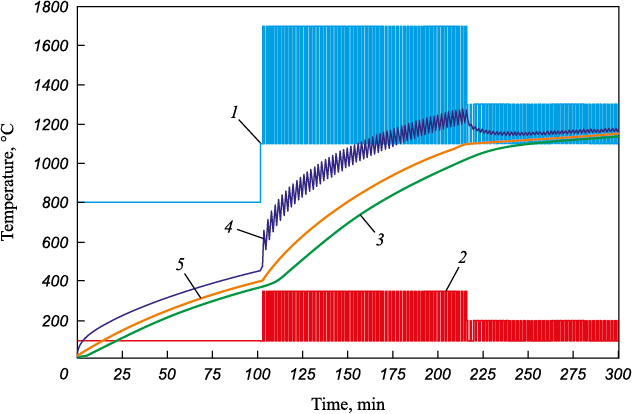Scroll to:
On the study of pulsed metal heating
https://doi.org/10.17073/0368-0797-2023-5-613-615
Abstract
The work makes it possible to simplify development of pulsed metal heating technology. A software product was created to select the optimal values of operating parameters of pulsed heating on a mathematical model, which significantly reduces the setup time of a thermal unit using this technology. Test calculations showed adequacy of the results obtained to the operating parameters of functioning through-pass heating furnaces equipped with high-speed jet burners. The problems of controlling metal heating became particularly relevant due to the proliferation of high-performance rolling mills and increasing requirements for the quality of metal heating. In this regard, full implementation of the research program will make it possible to develop specific recommendations for increasing the productivity of heating furnaces and improving their energy efficiency.
Keywords
For citations:
Apasova A.D., Levitskii I.A., Shatokhin K.S. On the study of pulsed metal heating. Izvestiya. Ferrous Metallurgy. 2023;66(5):613-615. https://doi.org/10.17073/0368-0797-2023-5-613-615
The pursuit of hidden reserves of energy-saving measures and their utilization represents a crucial factor in enhancing the competitiveness of products. Among finished products, rolling production ranks second in terms of energy consumption, following blast furnace ironmaking. Notably, gas and electricity constitute 95 % of the costs, with 60 % allocated to the heating of ingots for the rolling process [1].
When calculating energy costs in the technological process of metal heating, several approaches are considered:
– manufacturing furnaces with minimal heat release into the environment and the impact of these losses on the metal heating process;
– achieving optimum metal processing temperatures within a shorter duration;
– enhancing the automatic process control system [2 – 4].
The method employed for heating metal ingots, adhering to specified requirements, must achieve optimal temperature conditions within a brief period while exerting localized effects yet transferring adequate heat for processing ingots have a localized effect, but at the same time transfer enough heat to process ingots. Pulse modes of metal heating are considered a technology that fulfills these criteria.
High-speed jet burners operating on natural gas constitute the primary class of burner devices utilized in pulsed heating systems [5]. Pulsed heating relies on either an automatic interrupt-based positioning system or an interruption system with adjustable pulse frequency and ratio, where the “on-off” period ranges from 0.5 to 2.5 min. The convection coefficient aconv can reach 300 W/(m2·K) or higher [6].
Determining the operating mode of the burners is typically achieved through experimentation during the setup of thermal generating units, a process that is time-consuming due to the high thermal inertia of furnaces. Hence, it is advisable to preliminarily determine the operating parameters of pulsed heating using a mathematical model.
A program has been developed to simulate the outcomes of the following process: an ingot in the form of a plate or cylinder, possessing a homogeneous temperature field, is placed within a through-pass heating furnace. In this setup, the zones are defined with specific temperatures and aconv values corresponding to the “on” and “off” states of burners. The “on – off” modes switch once the set heating time t or the set temperature difference ∆T across the ingot’s thickness is reached.
Pulse mode of metal heating: |
The provided figure illustrates the furnace temperature conditions and the metal heating interval, considering the following parameters:
– temperature in the methodical zone without burners: 800 °C, aconv : 100 W/(m2·K);
– temperature and aconv in the welding zone for the “on” and “off” modes: 1700 °C and 300 W/(m2·K), 1100 °C and 100 W/(m2·K), respectively;
– temperature and aconv in the soaking zone for the “on” and “off” modes: 1300 °C and 200 W/(m2·K), 1100 °C and 100 W/(m2·K), respectively;
– burners’ operation and shutdown time: 1 min.
Conclusions
The software product has been developed to optimize the operating parameters for pulsed heating of metal in through-pass heating furnaces.
Successful implementation of the research program will enable the formulation of recommendations aimed at improving furnace productivity and enhancing the energy efficiency of the ingot heating process.
References
1. Fastykovskii A.R. Energy saving technology for rolling varietal profiles. Tekhnicheskie nauki – ot teorii k praktike. 2016;11(59):52–56. (In Russ.).
2. Korobeinikov V.V., Tkachenko S.S. Energy saving heating units of new generation. Lit’e i metallurgiya. 2017;3(88): 34–38. (In Russ.).
3. Panferov V.I. About economic management of heating metal in industrial furnaces. Vestnik YuUrGU. Series: Computer technologies, control, radio electronics. 2018;18(2):71–80. (In Russ.). https://doi.org/10.14529/ctcr180207
4. Andreev S.M., Parsunkin B.N., Akhmetov T.U. Perfecting information support energy-saving modes of heating metal. Russian Internet Journal of Industrial Engineering. 2015;3(2):122–127. (In Russ.).
5. Boom R. Research Fund for Coal and Steel RFCS: a European success story. Ironamking & Steelmaking. 2014;41(9):647–652. https://doi.org/10.1179/0301923314Z.000000000313
6. Sibikin Yu.D., Sibikin M.Yu. Technology of Energy Saving. Moscow: FORUM, INFRA-M; 2006:352. (In Russ.).
About the Authors
A. D. ApasovaRussian Federation
Anna D. Apasova, Postgraduate of the Chair “Energy-Efficient and Resource-Saving Industrial Technologies”
4 Leninskii Ave., Moscow 119049, Russian Federation
I. A. Levitskii
Russian Federation
Igor’ A. Levitskii, Cand. Sci. (Eng.), Assist. Prof. of the Chair “Energy-Efficient and Resource-Saving Industrial Technologies”
4 Leninskii Ave., Moscow 119049, Russian Federation
K. S. Shatokhin
Russian Federation
Konstantin S. Shatokhin, Cand. Sci. (Eng.), Assist. Prof. of the Chair “Energy-Efficient and Resource-Saving Industrial Technologies”
4 Leninskii Ave., Moscow 119049, Russian Federation
Review
For citations:
Apasova A.D., Levitskii I.A., Shatokhin K.S. On the study of pulsed metal heating. Izvestiya. Ferrous Metallurgy. 2023;66(5):613-615. https://doi.org/10.17073/0368-0797-2023-5-613-615


































